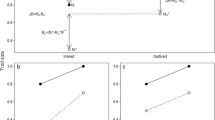Summary
-
1.
This paper describes experiments on a strain ofDrosophila melanogaster which long-continued selection failed to make homozygous, and discusses a gene model put forward to explain its behaviour.
-
2.
Under selection for long wings, the strain has remained for more than fifty generations in unstable genetic equilibrium, characterized by a phenotypic variance 50 % greater, and size 8% greater than in the unselected (control) stock.
-
3.
When selection is relaxed or reversed, variance declines sharply and the deviations of wing and thorax length decline by 50 and 20 %, respectively.
-
4.
No second-chromosome lethals were found in the selected stock, but some flies were homozygous for a third-chromosome gene-or block of genes-which was lethal in the genetic background of the lethal test.
-
5.
Progeny tests indicated that about 50% of the variance of wing length was due to additive genetic effects, compared with 40% after a generation of relaxed selection, and 30 % in the unselected stock. Selection appeared to have increased the additive genetic variance 2 1/2 times, leaving the remaining variance (other genetic plus environmental) unchanged.
-
6.
Additional tests indicate that, in spite of the appearance of additiveness given by the progeny tests, artificial selection has been favouring the flies most heterozygous for genes affecting body-size.
-
7.
A genetic asymmetry in the relative changes of wing and thorax length during selection for large and small size is discussed.
-
8.
The genetic correlation between wing and thorax length is about 0.75 in the unselected stock, and even higher (0.86) after selection. Other evidence supports this conclusion. Nevertheless, wing length declines relatively 2 1/2 times as much as thorax length, when selection is relaxed.
-
9.
This apparent contradiction may be due to a postulated effect of continued selection in modifying the effects of unfixed genes on the selected character. Comparison of the genetic variances of the two characters before and after selection lends some support to this hypothesis.
-
10.
There is a negative correlation between parent size and viability, in progeny tests on the selected strain, which appears to be due mainly to a correlation between size and larval mortality; but this alone could not account for the failure to advance under selection. Neither sterility nor mating behaviour can account for this failure and some further genetic mechanism must be at work.
Similar content being viewed by others
References
Fisher, R. A. (1930).The Genetical Theory of Natural Selection. Clarendon Press, Oxford
Haldane, J. B. S. (1953). In the Press.
Lush, Jay L. (1949). Heritability of quantitative characters in farm animals.Proc. 8th hit. Congr. Genet., Lund.
Mather, K. (1949).Biometrical Genetics. London: Methuen.
Mather, K. &Harrison, B. J. (1949). The manifold effect of selection.Heredity 3, 1.
Reeve, E. C. R. (1950). Genetical aspects of size allometry in ‘A discussion on the measurement of growth and form’.Proc. Roy. Soc. B,137, 515.
Reeve, E. C. R. (1953). Studies in quantitative inheritance. III. Heritability and genetic correlations in progeny tests using different mating systems.J. Genet. (in the Press).
Reeve, E. C. R. &Huxley, J. S. (1945).Essays on Growth and Form. Oxford
Robertson, F. W. &Reeve, E. C. R. (1952). Studies in quantitative inheritance. I. The effects of selection of wing and thorax length inDrosophila melanogaster.J. Genet.50, 414.
Robertson, F. W. &Sang, J. H. (1944). The ecological determinants of population growth inDrosophila culture. I. Fecundity of adult flies.Proc. Roy, Soc. B,132, 258.
Wright, S. (1921). Systems of mating.Genetics,6, 111.
Author information
Authors and Affiliations
Rights and permissions
About this article
Cite this article
Reeve, E.C.R., Robertson, F.W. Studies in quantitative inheritance. Journ. of Genetics 51, 276–316 (1953). https://doi.org/10.1007/BF03023299
Issue Date:
DOI: https://doi.org/10.1007/BF03023299




